The ASUS ZenFone 2 Review
by Brandon Chester on May 26, 2015 8:00 AM ESTCamera Architecture
When it comes to generational camera improvements, the device it makes the most sense to compare the ZenFone 2 to is the ZenFone 5. Unfortunately, I don't have information about the exact sensor that was used in the ZenFone 5. On a basic level, ASUS has moved from an 8MP sensor to a 13MP one, while maintaining the same F/2.0 aperture. The rear camera flash has also been upgraded from a single LED to a dual LED "Real Tone" flash. The spec table below should provide some perspective on the technical aspects of the ZenFone 2's camera system.
| ASUS ZenFone 2 Cameras | ||||
| Front Camera - Resolution | 5MP (2560x1920) | |||
| Front Camera - Sensor | OmniVision OV5670 (1.12µm, 1/5") |
|||
| Front Camera - Focal Length | 3.3mm | |||
| Front Camera - Max Aperture | F/2.0 | |||
| Rear Camera - Resolution | 13MP (4096x3072) | |||
| Rear Camera - Sensor | Toshiba T4K37 (1.12µm, 1/3.07") | |||
| Rear Camera - Focal Length | 3.8mm (28m eff) | |||
| Rear Camera - Max Aperture | F/2.0 | |||
The ZenFone 2 is the only device I know of to use Toshiba's T4K37 sensor. This is a sister sensor of the T4KA7 used in the HTC One (M9), which has the same pixel size but a higher 20.7MP resolution and thus a larger sensor. However, the sensor is just one part of the optical system, and I wouldn't draw any conclusions about the ZenFone 2's camera quality based on another phone that uses a similar sensor.
ASUS is using a fairly fast aperture of F/2.0 for both the front and back sensors. While this allows for more light to be collected, it can also cause visible aberration in photos and alters the depth of field in photographs. Unfortunately, there's no OIS on the rear-facing camera to compensate for hand shake which could enable longer exposures. What I find interesting is that ASUS never pushes the camera beyond a shutter speed of 1/12s and never exceeds an ISO of 1600. I had thought the max ISO might be a bit higher in the darkest of scenes.
Now that the hardware of the camera system is out of the way, I want to touch on the auto-focus and capture latency on the ZenFone 2. This is a best case test where the camera is pointed at a bright and high contrast target, and so the results for capture time and auto-focus time will vary depending on the lighting of the scene. In particular, the longer exposure times in low light will cause a significant increase in capture latency.
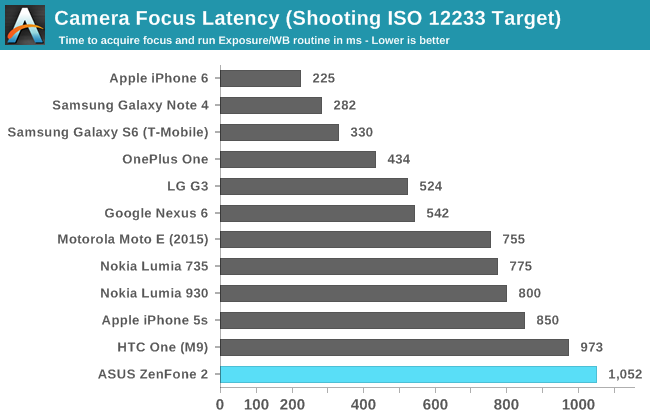
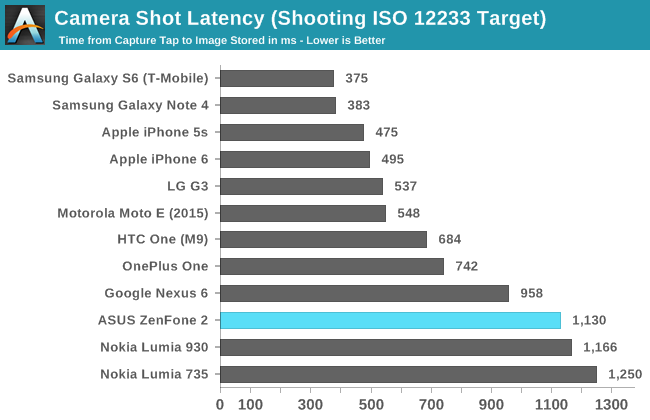
In the focus latency test, the ZenFone 2 ends up being the slowest device on the chart. It's around the same speed as the HTC One (M9) but this is likely due to a lack of PDAF/laser AF and similar troubles with ISP rather than anything related to the camera sensor itself. Shot latency is also fairly long, but not the worst result we've seen. Prior to a recent update, the shot latency was an extremely long 2.4 seconds, and so the current result is a significant improvement over my first tests. It's still very long though, and it's something I would attribute to the ISP that is used, as the ZenFone is in no danger of running out of free RAM to use as a buffer for photos which rules out issues with NAND write speeds.
Camera UX
The camera application on a smartphone can have an enormous impact on the shooting experience. The application needs to have a well designed layout for the controls, which can be a difficult balance between exposing too many things on the screen and hiding too many options in layers upon layers of menus. Equally important is making sure that the preview has a high frame rate so the user can see how stable the camera is, as well as a high resolution and an accurate aspect ratio so photos can be framed and composed properly. Using a camera can be a frustrating experience when any of these aspects are handled poorly, and it can lead to a potential photo opportunity being missed as the user fights with the camera application.
The camera interface on the ZenFone 2 is fairly well designed, but there are a few things that the user needs to tweak before they begin using it. The most important part is the photo resolution setting. By default, the camera is set to take cropped 10MP 16:9 photos. Given that the camera is a 4:3 13MP sensor, the only reason I can explain the default setting is that it means there's no switch in preview size between taking photos and shooting video. In any case, I immediately changed the setting to 13MP, and all the photos in the review were taken in that configuration. Another setting I enabled was touch auto exposure, which is just something I personally prefer to have enabled.
As for the auto mode interface, it has a good balance of exposing necessary controls and hiding more seldom used ones. On the right side there are buttons to take photos and shoot video, as well as a button in the bottom right which allows you to change between the various shooting modes. Another button may dynamically appear in the bottom left depending on your shooting conditions, and it may tell you to change to various other shooting modes to improve photo quality. In this case, it's recommending to use the low light mode because the preview is very dark.
The gear on the left side of the display opens up the settings menu. This menu is basically a very long list of options, so I'm glad that Asus thought to put shortcuts on the top that can bring you right to a specific group of settings that pertain to a certain shooting mode. You'll also notice that even though we're using auto mode, this menu can be used to force certain settings like the exposure bias, the ISO, and the white balance. There are also some additional settings for sharpness, contrast, saturation, etc. I don't really see the value of these options outside of a manual mode, as a good auto mode should be capable of determining the best values for these settings on its own.
The last part of the camera UI that I want to discuss is the manual mode. I think ASUS actually has one of the better implemented manual camera modes that I've seen on a smartphone, although it's not without its issues. As you can see above, the manual mode comes with a histogram and a gradienter. These are nice features for users who will need them, and ASUS gives you the ability to turn them off which I have done for both of them as I find them distracting when trying to compose photos. You'll also notice that in this mode the photo and video shooting modes are split into two sections that you access via a slider, rather than having both buttons on the screen at the same time. This is because the video mode is locked to 30 frames per second and so the shutter speed controls have to be removed from the menu.
To adjust settings like shutter speed, ISO, white balance, etc, you simply tap on the blue slider button in the top right. This brings up a menu with two columns, where the different settings are stacked in the right column, and the values for those settings are in the left column. I like this design because it's easy to use with a single finger on the right side of the device, and when it's closed you can still see the values you've chosen in the top left of the camera preview.
My one big issue with ASUS's manual controls is that the steps between possible values are not very fine. For example, you can see above that your options for ISO are limited to values that double in size as you go up the scale. While many professional DSLRs and mirrorless cameras also don't offer the ability to select any desired ISO value, they have a large range of values that you can select. For example, where the ZenFone 2 goes from 100 to 200 ISO, my camera has 125 and 160 in between. There are also apps for iOS and Android that allow you to select any value for the ISO. What also bothers me is that the range of ISO values stops at 800, while the auto mode will push ISO as high as 1600 in low light. The shutter speed is also capped at 1/500 seconds, which is much longer than some of the shutter speeds the phone will use in good lighting.
Since ASUS can push updates to their apps via Google Play, I'm hopeful that they will improve on this with a future camera update. They already have a solid interface and a good set of features, and there's just a few things that they haven't gotten quite right yet.


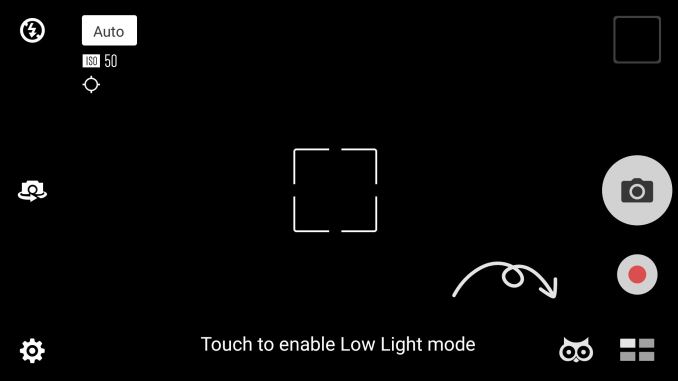
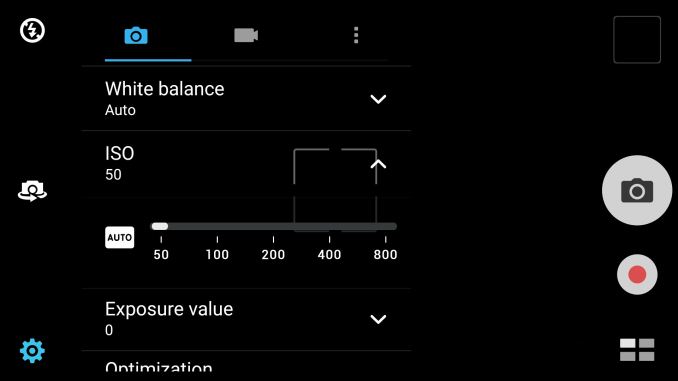
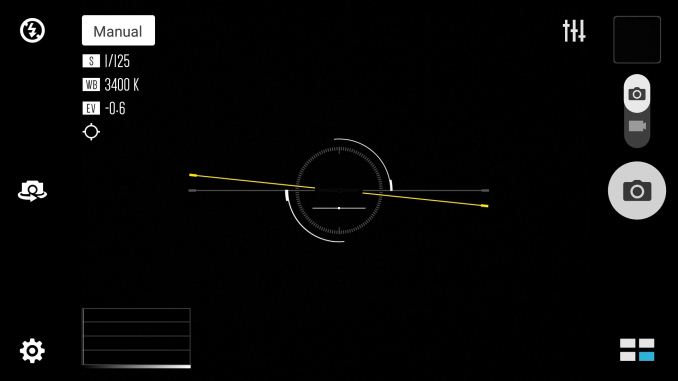









147 Comments
View All Comments
jt122333221 - Tuesday, May 26, 2015 - link
Heads up - it also supports double-tap to sleep. Unfortunately, you have to double-tap on a completely empty portion of the display (empty homescreen or in the notification bar) to get it to sleep.mkozakewich - Tuesday, May 26, 2015 - link
Put Cherry Trail in here with Window 8 (and then 10) and it would totally be what I'm looking for in a phone. I'm going to have to keep my eyes open.commenter001 - Tuesday, May 26, 2015 - link
I just bought the 4GB model. I've actually been using it more than my S6! What the review kinda skipped on was real world usage of the device. This thing doesn't skip a beat. It's amazing how many apps you re-open and they're right back where you left them (hours ago). Unlike the S6 where it seems to reload every dang time just after normal usage. The power button is not a big deal, I use the double-tap on the screen to wake it up all the time.The battery life is not that horrible, gets me through the day and I'm in poor cell area most of the time. Video and pictures, yeah, they're pretty average.
Again, I'm amazed at the lack of the usual lagginess that I've come to accept from Android. Maybe it'll creep up over time but so far this phone is on par or exceeds the S6 just in real world day-to-day stuff for me.
ketacdx - Thursday, May 28, 2015 - link
I agree man, this thing is surreal for real world usage. Battery really is pretty decent, mine is about 2% right now with 24 hrs on, 3hrs49mins of which are screen on time. Only thing I notice with mine is Android OS is using 31% of battery with CPU total at 10hrs 16 mins. I can only assume a glitch or Android issue that hopefully repairs with updates. Either way, pretty decent!! :)blzd - Thursday, May 28, 2015 - link
I'd say that's less of an accomplishment from Asus and more of a standard failing from Samsung and Touchwiz.Have you tried any other recent Android devices? Nexus devices and Motorola using stock Android have felt just as snappy and fluid for years now and it's only gotten better with Lollipop.
hans_ober - Tuesday, May 26, 2015 - link
How would this compare to the Xiaomi Mi 4i? In India, the lowest model of the Zenfone 2 is price competitive with the Xiaomi Mi 4i, which I hope AT manage to get their hands on.aryonoco - Wednesday, May 27, 2015 - link
Great article. Thanks to your work Brandon, I'm beginning to not even miss Brian any moreThis was a pleasure to read. Thank you.
lvchubby - Wednesday, May 27, 2015 - link
I'm a newcomer and respect Anandtech's true reviews instead of some others which look like marketing articles, but there's something missing about this review. I agree that the device is very value for money, but there are also quite a large number of complaints on Taiwan's user forums (in Chinese of coz) about QC and compatibility issues every time Asus launch a new phone in Taiwan. Sadly it happens repeatedly and Zenfone2 is not an exception, and still many people bought it due to it's CP value. Some of them were blaming Asus for using them as beta testers before the international launch. That's why I'm still holding up my decision.I'm not saying the Zenfone2 is not a good device, but for those who wanna buy it, I'd suggest holding up your decision for a few months till Asus hopefully solving most of the compatibility issues by software updates. Also check carefully for any faults when u receive the device.
As a side note, there are some local reviews/users saying the 3Gb RAM is not quite enough as the Zen UI eats up much RAM, and 4Gb RAM version is recommended.
chrnochime - Wednesday, May 27, 2015 - link
You mean like this thread from mobile01(yeah I read Chinese too):w w w . mobile01 . com/topicdetail.php?f=588&t=4395771
Hopefully this will force them get their shit together since they're now selling in the US...
lvchubby - Wednesday, May 27, 2015 - link
U can find similar posts even in Asus' own forum:http://w w w . asus . com/zentalk/tw/forum.php?mod=forumdisplay&fid=174
And imo it's a shame that the CEO admitted the beta tester thing...
http://w w w . mobile01 . com/topicdetail.php?f=588&t=4332578